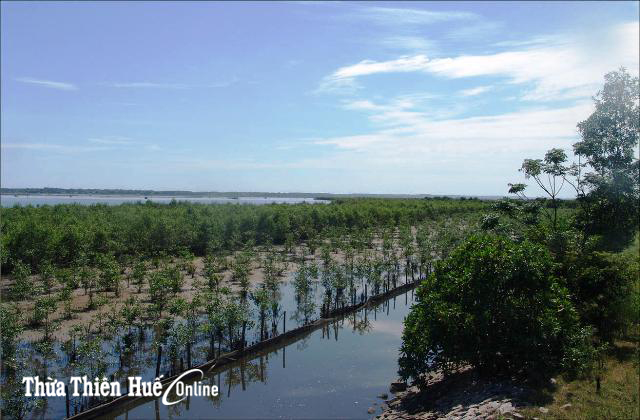While the dike system in many places has been damaged and eroded by the recent floods, the one in Quang Loi commune (Quang Dien) has remained still intact, protecting the local aquaculture ponds (AP).

Tam Giang lagoon mangrove forest becomes a shield protecting aquaculture ponds in Quang Loi commune.
After the big flood in early November and the recent flood, people in Quang Loi commune are reassured because the dike system and the APs are not damaged and eroded as they were in the floods many years ago.
Mr. Dang Hoang cannot hide his joy when his prawn ponds are still intact after the floods. Several years ago, after floods, the dike system was so damaged that it cost a lot to repair. According to Mr. Hoang, the dike surrounding the APs is kept safe thanks to the protective mangrove forest in Tam Giang lagoon that was planted a couple of years ago. To date, the forest has been growing rapidly, enhancing the protection of the ecological environment, biodiversity in Tam Giang lagoon and also protecting the dike system surrounding the APs.
Vice Chairman of Quang Loi Commune People's Committee Phan Dang Bao affirmed that without the mangrove forest, the dikes and ponds in the area would have been eroded by the recent floods. Several years ago, after each flood, the dike system was severely damaged, and each household had to spend millions of VND on repair.
With nearly 20 hectares of APs in Tam Giang Lagoon farmed by 40 households, prawn cultivation is identified as one of the spearheads for economic development of the locality. In the recent years, due to the effects of climate change and complicated irregular floods, the dike system and APs were eroded causing great financial loss.
Previously, local people did not apply any active interventions to the pristine lagoon area in Quang Dien to tackle the climate change and increasing natural disasters. In the typhoon seasons, big waves hit and damaged the dike and APs in communes near Tam Giang lagoon, adversely affecting the livelihoods of local people. Cultivation of mangrove forests along the edge of the lagoon is indispensable to the protection of local aquaculture and the local tourism development. The cultivated nipa palm and mangrove forests on the mudflats are an advantage for Quang Dien to develop ecotourism in the next few years.
Over the past years, the provincial Department of Forest Rangers in collaboration with Quang Dien district has planted 37.5 ha of mangrove forest in Tam Giang lagoon, including nipa palms and mangroves. Thanks to good management and protection, the forest has been well-developed and become the habitat for aquatic species. The Department of Forest Rangers continues to expand the area of mangrove forest in coastal communes, in connection with the planning of aquaculture and the development of ecotourism and services in Quang Dien district. After well-established, the forest will become a highlight for ecological tourism development at Tam Giang lagoon.
According to Pham Ngoc Dung, Deputy Head of the provincial Forest Ranger Department, efforts to plant mangrove forests in Tam Giang lagoon in Quang Dien district have been effective. The mangrove forests not only protect the aquaculture but also the paddy fields in the locality. It is thanks to the mangroves that aquaculture ponds, dikes, roads, and other infrastructures do not suffer from erosion and damage in the typhoon season.
Recently, the 15 km long belt of mangroves along the Tam Giang - Cau Hai lagoon has been able to withstand heavy floods, effectively protecting the local APs and other infrastructures. Local residents are now reassured about their aquaculture and agricultural production in the current circumstances of climate change, and complicated unpredictable storms and floods.
Story and photo: Hoang The